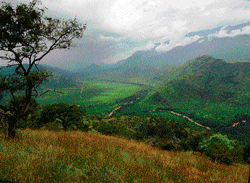
Sathyamangalam, Tamil Nadu’s largest wildlife sanctuary, has recently been given the status of a tiger reserve. This will not only protect the tiger, but also the rest of the ecosystem, writes Ganashree Kedlaya.
The largest wildlife sanctuary in Tamil Nadu, Sathyamangalam, envelopes 1,455 sq km of forest area, acting as a critical wildlife corridor in the Nilgiris. Having received sanctuary status in November 2008 for its rich biodiversity, it is now a tiger reserve with effect from March 15 this year.
The National Tiger Conservation Authority (NTCA) recently declared five tiger reserves in India — Pilibhit in Uttar Pradesh, Ratapani in Madhya Pradesh, Sunabeda in Orissa, Mukundata Hills in Rajasthan and Sathyamangalam in Tamil Nadu.
This status for Sathyamangalam has been a long wait. Initiated by Jairam Ramesh, the former Environment and Forest Minister in July 2010, the drive to baptise this forest was religiously followed up by erstwhile chief minister Karunanidhi and kept abreast by Chief Minister Jayalalitha, in 2012. Cradled by the Nilgiris biosphere, this hotspot, which hosts an active population of threatened species in the country, needs protection and allegiance.
The habitat
This expansive forest supports vegetation types ranging from tropical dry thorn forest, tropical dry mixed deciduous forest to sub-tropical hill forest and even a tropical semi-evergreen forest. It adjoins the Biligiriranga Swamy Temple Wildlife Sanctuary and Bandipur National Park in Karnataka, and Sigur Plateau and Mudumalai National Park in Tamil Nadu.
In 2011, 88,726 hectares were added in seven reserve forests of Sathyamangalam to the existing 52,434 hectares. The forest now comprises the Thalavady range (Palayam, Belathur, Gettavadi), Bhavani Sagar range (Thengumarahada, a part of Thalamalai, Gejalatti, Peerkadavu, Kothamangalam and a part of Bannari), Sathyamangalam range (Thimbam, Vadavalli, Chickarasampalayam, Kondappanaicken Palayam and Kembanaiken Palayam, Guthiyalathur and Guthiyalathur extension), T N Palayam (a part of Kadambur forests, Vilankombai, Kongarpalayam, a part of Kovilur, Kanackampalayam and a part of Kundri).
The core zone of the total area of the forest comprises over 90,000 ha and the Indian government has earmarked 1.40 lakh ha as exclusive protection zone for tigers.
Thirteen per cent of mammal species found in India are present in Sathyamangalam.
An abundance of ungulate population in these forests sustains a thriving healthy population of large carnivores like tigers, leopards and striped hyenas. This reserve serves as a vital link between the Eastern Ghats and the Western Ghats functioning as a critical corridor allowing tigers, elephants and other wildlife to easily migrate in a landscape that is heavily used and populated by people.
According to the population estimation survey conducted by the Forest Department in 2009, there were 10 tigers in the sanctuary.
There is a huge change in this numbers game now, with a significant recovery in tiger population density (the 2012 survey suggests 25). The last tiger mortality reported in the area was on January 21, 2013, when a ten-year-old male succumbed to a territorial fight. The 2010 survey by the Forest Department suggests an elephant population of over 900 and a healthy recovery in the vulture population was observed in 2011.
What next?
This forest has a ‘past’, so to say! A hideout and a preferred base of the country’s biggest brigand, Veerappan, who stalked Sathyamangalam for many years. This misuse by the State’s most wanted elephant slayer furnished a flipside edge that was unforeseen.
The forest was out of reach to many, and hence threats like encroachments and collection of Minor Forest Produce (MFP) was unheard of in the area. After Veerappan was killed in the year 2004, 28 village forest committees were set up to collect MFP from the reserve.
Today, there are over 900 families living within the reserve, mostly in the Thalavady and Kadambur hills. There are over 138 villages located within five-km radius surrounding the reserve, of which three settlements are located within the forest.
The Irulas and the Kurumbas are the two major communities that collect honey, tubers, fish and fuel wood. Most people living close to the forest boundary rear goats and poultry birds. In the month of November 2012 alone, there were more than 27 goats killed by leopards. This is not the only concern.
There has been a sharp rise in man-elephant conflicts in the area, leading to many elephants being electrocuted. Since January 2013, at least five elephant mortalities have been reported.
The threats are plenty — poaching, collection of various items of non-timber forest produce (NTFP) from the reserve, livestock grazing, frequent forest fires, invasive species (lantana camara, prosopis, juliflora, chromolaena and eupatorium) heavy dependence by local communities for fuel wood, and encroachment.
Enhanced scientific research and studies should be encouraged to accurately estimate population densities of wildlife found in the reserve and establishing effective and long-term monitoring in the reserve. With protests from tribals against the very decision of declaration mounting, biotic pressure has to be reduced by encouraging people’s participation in conservation through education. The socio-economic bearings need to be understood and effective measures should be taken to abate human-animal conflicts.
Sathyamangalam is listed one among the top five hotspots in India for big cat poaching by the international wild life trade monitoring network, TRAFFIC. Making this sanctuary a tiger reserve is an infallible decision, one that will not only protect the country’s flagship species, the tiger, but also the entire ecosystem.